 锦泰留学网
锦泰留学网"Dyeing留学" is a phrase that combines the English word "dyeing" and the Chinese term "留学" (liúxué), which means "study abroad".
However, it is worth noting that "dyeing" is not related to the concept of studying abroad or education. "Dyeing" refers to the process of coloring or changing the color of something, usually by adding dye or pigment.
So the phrase "Dyeing留学" seems to be a combination of unrelated terms and does not have a specific meaning in English or Chinese.

Dyeing and finishing refer to the processes involved in coloring and enhancing the appearance of textiles or fabrics.
Dyeing is the process of imparting color to textiles using dyes, which are substances that can chemically or physically bond with the fibers of the fabric. There are various methods of dyeing, including immersion dyeing (where the fabric is submerged in a dye bath), direct dyeing (where the dye is applied directly to the fabric), and printing (where a design is printed on the fabric using dyes).
After the dyeing process, finishing techniques are applied to the fabric to enhance its properties and appearance. Finishing may involve various treatments like bleaching, mercerization (treating with caustic soda to improve luster and strength), calendering (pressing the fabric with heated rollers to create a smooth texture), or coating (applying a layer of chemicals or polymers to modify the fabric's properties).
Finishing can also include processes like waterproofing, flame-retardant treatment, anti-static treatment, or anti-wrinkle treatment, depending on the desired properties of the fabric. These treatments can enhance the fabric's performance, durability, and aesthetic appeal.
Overall, dyeing and finishing play crucial roles in the textile industry, allowing manufacturers to produce fabrics in a wide range of colors, textures, and functionalities to meet the demands of various applications.
Dyeing is translated as "染色" (rǎn sè) in Chinese.